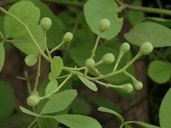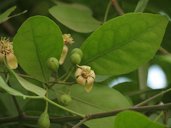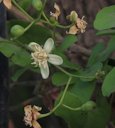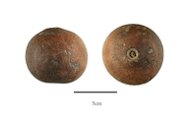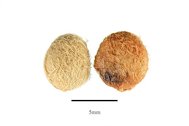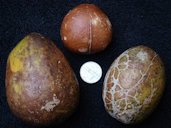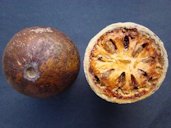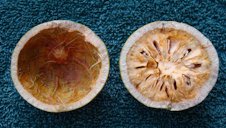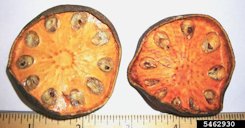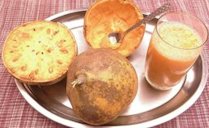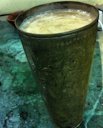| Bael - Aegle marmelos | |||||||||||||||||||||||||||||||||||||||||
|---|---|---|---|---|---|---|---|---|---|---|---|---|---|---|---|---|---|---|---|---|---|---|---|---|---|---|---|---|---|---|---|---|---|---|---|---|---|---|---|---|---|
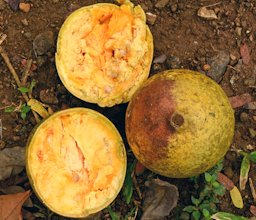 Fig. 1  Aegle marmelos, fruits, one opened, Puerto Rico: Mayaguez Municipality Co. 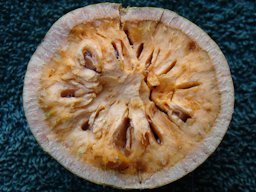 Fig. 2  Close-up of a half of a ripe bael fruit (cracked open by a hammer), collected from the grounds of the Mounts Botanical Garden, West Palm Beach, Florida 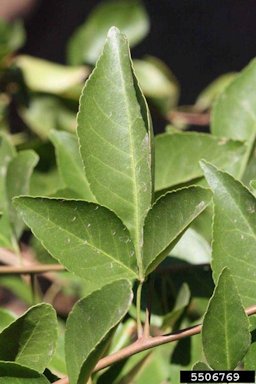 Fig. 3  Bael (A. marmelos cv. Bael, trifoliate leaf 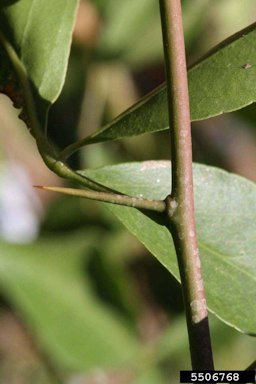 Fig. 4 First year twig with thorn 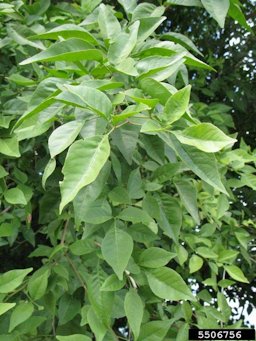 Fig. 5   Fig. 10  A. marmelos, Velugonda hills of Nellore district. Common in open forests and often cultivated. This is a sacred tree for Hindus. Found in India, Srilanka and Java. 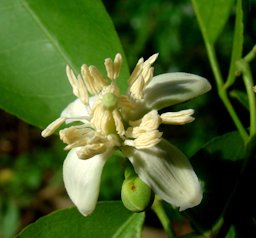 Fig. 11  Bengal Quince flower, Kankeshwar, Maharashtra, India 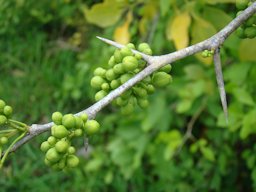 Fig. 15  Clusters of very young fruits hang from a Bael (A. marmelos/Rutaceae) tree in the Fruit And Spice Park, Homestead, Florida. Note the Bael's famous long, hard and pointed thorns along the branches of the tree. 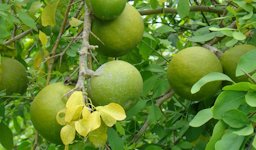 Fig. 16  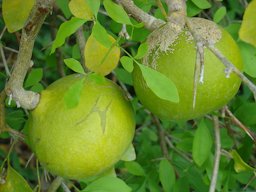 Fig. 17  Close-up of a few mature but unripe fruits hanging from a bael tree in the Fruit And Spice Park, Homestead, Florida. Note the Tri-foliate leaf arrangement so typical of Bael. 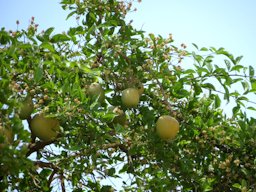 Fig. 18  Bengal Quince, Kasavanahalli, Karnataka, India 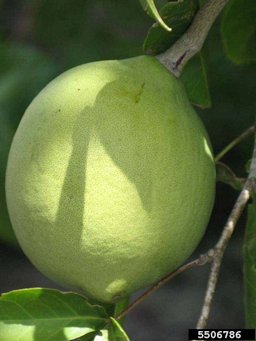 Fig. 19 Bael, Aegle marmelos cv. Bael Mature but unripe fruit 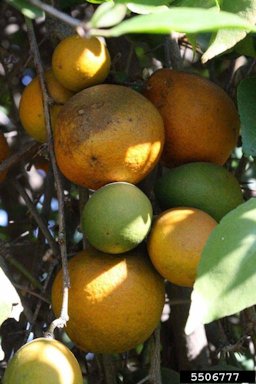 Fig. 20  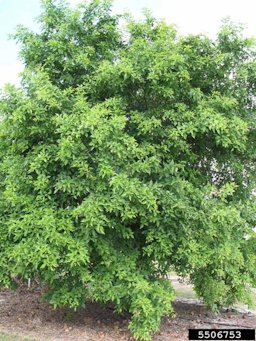 Fig. 27  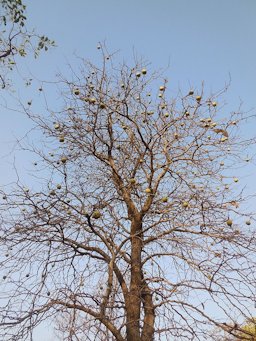 Fig. 28  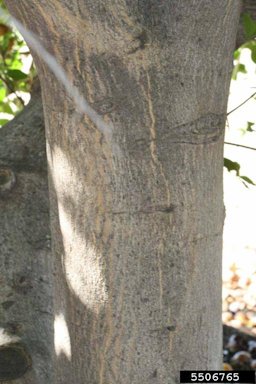 Fig. 29 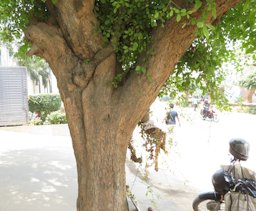 Fig. 30 Bengal quince A. marmelos, Kasavanahalli, Karnataka, India  Fig. 31  Bela pana. Bael sarbat or wood-apple juice, a healthy and cool drink. Perfect drink for the summer. Especially on Pana Sankranti people of Odisha celebrate this day with Bela pana. This day also been celebrated in many parts of India as New year festival, Maha Vishuba Sankranti, Bihu, Vishu, Baisakhi. 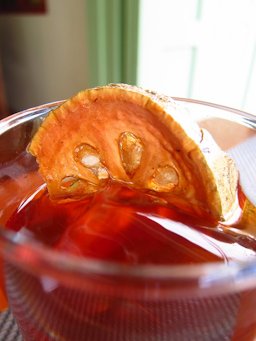 Fig. 32 Iced cinnamon bael fruit tea, Luang Prabang, Laos 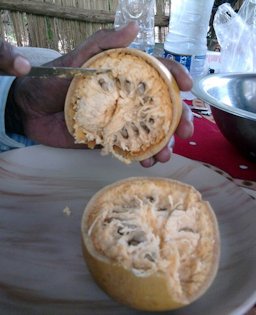 Fig. 36  Bael, Indian fruit used in Shiva rituals (pooja) so it's called "Shiva's fruit". It has many therapeutic uses in Siddha and Ayurveda medicine. The juice is delicious! 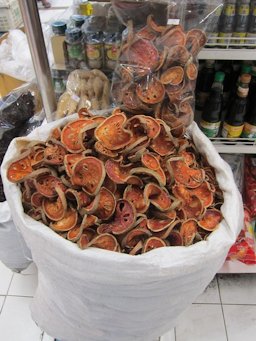 Fig. 37 Dried bael fruit, Thai 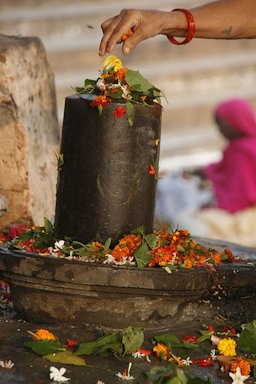 Fig. 38  Bael leaves used in the worship of a lingam - the icon of Shiva. Hindu sculpture of Aikya Linga in Varanasi, India |
Scientific
name Aegle marmelos (L.) Corrêa Common names English: bael fruit, bael fruit tree, bael tree, ball tree, bel fruit, bela tree, Bengal quince, elephant apple, golden apple, holy fruit, Indian bael, Indian quince, maredoo, quince-apple of India, stone apple, wood apple; Dutch: slijm appelboom; French: egle marmel, bel Indien, cognassier du Bengal, coing de l’Inde, oranger de Malabar, oranger du Malabar; German: Bälbaum, Belbaum, Bengalische Quitte, Indische Quitte 2 Other Common Names Synonyms A. marmelos var. mahurensis Zate, Belou marmelos (L.) Lyons, Bilacus marmelos (L.) Kuntze, Crateva marmelos L., C. religiosa Ainslie, Feronia pellucida Roth 3 Relatives Distant relative of all citrus species; kumquat (Fortunella spp.); white sapote (Casimiroa edulis); elephant apple (Feronia limonia) 11 Family Rutaceae (citrus family) Origin Indigenous to Peninsular India, Pakistan, Bangladesh and Myanmar 2 USDA hardiness zones 10-11 7 Uses Fruit; living barrier; xerophytic 12 Height Up to 40-50 ft (12-15 m) 4,9 Spread 30-40 ft (9-15 m)11 Crown Round; densely floiated 11 Growth rate Slow-growing 4 Trunk/bark/branches Short trunk; thick, soft, flaking bark; spreading, sometimes spiny branches, lower ones drooping 4 Leaves Deciduous (not in south Florida); alternate; borne singly or trifoliate; new foliage glossy, pinkish-maroon; crushed mature leaves emit a disagreeable odor 4 Flowers Flagrant; clusters of 4-7; 4 recurved, fleshy petals, green outside, yellowish inside; 50 or more greenish-yellow stamens 4 Fruit Subglobose berry; hard woody shell; sticky, edible soft pulp; yellow or orange; very fragrant; pleasantly flavoured 5 Season July-Aug. 11 Light requirement Sun, it cannot grow in the shade 7 Soil tolerances Said to do best on rich, well-drained soil, but it has grown well and fruited on the oolitic limestone of southern Florida 4 pH preference Can be grown in acidic or alkaline; range of 5-10 10 Drought tolerance Drought tolerant; prefers a monsoonal climate with a pronounced dry period 11 Cold tolerance As low as 17.6 °F (-8 °C) 10 Plant spacing 20-30 ft (6-9 m) between trees 9 Invasive potential * None reported Pest/disease resistance Relatively free from pests and diseases except for the fungi causing deterioration in storage 9 Known hazard Has sharp spines capable of causing mechanical injury; leaves and bark are thought to contain toxins 11 Reading Material Bael Fruit, Fruits of Warm Climates The Bael, West Australian Nut and Tree Crop Association Aegle marmelos, PROSEA Foundation Aegle marmelos, Agroforestry Database Bael, NewCROP™, Purdue University Origin Bael grows wild in dry forests in the Indian Peninsula, Sri Lanka, Pakistan and Bangladesh. It is an old cultivated tree in that region, particularly found in temple gardens in India. It has spread to Indo-China, South-East Asia (in particular Thailand, northern Malaysia, eastern Java and northern Luzon) and other parts of the tropics. 5 In Thailand, it is commonly found growing in many Buddhist temples as its dried, sliced fruit is boiled with water and used as a popular drink for monks. 6 Description It is the only plant belonging to the monotypic genus Aegle. Sometimes it is called elephant apple, which causes confusion with a related fruit of that name, Feronia limonia Swingle (q.v.). 9 Bael fruit (Aegle marmelos (L.) Corr. Serr.) is an underutilized fruit of the Indian subcontinent. The tree can thrive under adverse agro–climatic conditions but its commercial cultivation is very limited. Bael fruit is one of the most nutritious fruits of India. 8 Bael Tree, Golden Apple or Bengal Quince is a mid-size, slow-growing deciduous tree native to India growing up to 18m in the right conditions. The fruits, leaves, twigs and root of the Bael tree are used medicinally. The tree is considered to be sacred by Hindus. Its fruits are used in traditional medicine, and as a food. It requires a pronounced dry season to give fruit. The orange fruits have an aromatic, pleasant-flavoured yellow pulp that is eaten either fresh or dry. The leaves and small shoots are eaten as salad greens. Flowers are fragrant. 7 Young suckers bear many stiff, straight spines. A clear, gummy sap, resembling gum arabic, exudes from wounded branches and hangs down in long strands, becoming gradually solid. It is sweet at first taste and then irritating to the throat. 4
Leaves the leaves are composed of 3 to 5 oval, pointed, shallowly toothed leaflets, 1 1/2 to 4 in (4-10 cm) long, 3/4 to 2 in (2-5 cm) wide, the terminal one with a long petiole. 9 Bael trees undergo only one flush of growth each year. Vegetative and reproductive shoots emerge simultaneously in the second half of May (in India) after leaf fall. The top terminal buds open first and bud burst in the entire tree is completed in seven to nine days. Four distinct types of shoots are noticed. Significantly higher numbers of fruits are formed on 1-year-old shoots than on (in descending order) 2, 3, 4-year-old shoots and old branches. The highest numbers of mature fruits are produced on the upper part of the tree followed by the middle and lower parts. 8
Fig. 9. Second - third year twig with thorns Flowers The bisexual flowers are nearly 2 cm wide, borne in clusters, sweet scented and greenish white. The shallow calyx has 5 short sepals and is pubescent on the outside. The 5 petals are oblong ovoid, blunt, thick, pale greenish white and dotted with oil glands. Stamens are numerous, sometimes coherent in bundles. Ovary are oblong ovoid, slightly tapering, axis wide, cells numerous (8–20), small arranged in a circle with numerous ovules in each cell. 10
Fig. 12,13,14. Bengal quince A.marmelos, Kasavanahalli, Karnataka, India Fruit Fruits are 2-3 in. (5-7.5 cm) in diameter, globose, oblong pyriform, rind gray or yellow, pulp sweet, thick yellow, orange to brown in color. Seeds are numerous and arranged in the cells surrounded by a slimy transparent mucilage. Seeds have wooly hairs. 10 Embedded in the pulp are 10 to 15 seeds, flattened-oblong, about 0.4 In. (1 cm) long, bearing woolly hairs and each enclosed in a sac of adhesive, transparent mucilage that solidifies on drying. 4 Since the pulp from ripe fruit turns brown and develops off-flavours during extraction and processing, ripe fruit so far could only be consumed fresh, and green fruit had to be used to make preserves. 5 The number of cells (seed cavities) in the fruit arranged in a circle is equal to the number of cells (seed cavities) in the ovary. Seeds are numerous, compressed and arranged in closely packed tiers in the cell surrounded by very tenacious, slimy, transparent mucilage, which becomes hard when dry. 8 The external colour of the fruit remains deep green until four months after fruit set, thereafter it gradually turns light green to yellowish-green, and on ripening it becomes yellow. The peel is soft initially but becomes hard, woody and finally brittle at the time of ripening. The internal colour of the fruit is light yellow in the early stages and the intensity increases to deep yellow with maturity and remains more or less the same until ripening. The shape of the fruit, which is oblong initially, turns spherical after four months and remains unaltered during the rest of the period of development and ripening. 8 Fruits take about 11 months to ripen. 10
Fig. 21. Display of 3 ripe and semi-ripe bael fruits during the Redland Summer Fruit Festival held in the Fruit And Spice Park, Homestead, Florida Fig. 24. A ripe (right), an over-ripe(left) and a dried-out Bael (top) fruits from Mounts Botanical Garden, West Palm Beach, Florida compared with a coin of 1 inch (2.54 cm) diameter Fig. 25. An over-ripe whole bael fruit at left is shown with a horizontally cut section (right) of another bael fruit from Mounts Botanical garden Fig. 26. Flesh scooped out of one of the halves of a ripe bael fruit (cracked open by a hammer), collected from the grounds of the Mounts Botanical Garden Varieties Various selections have been made in regions where the bael fruit is popular. The cultivars 'Kaghzi' and 'Mitzapuri' are well regarded. Most Florida specimens are gron form seed. 11 Harvesting The fruit ripens in the dry season, when most leaves have been shed in anticipation of bloom for the next crop. Bael fruit is picked individually and should not be allowed to drop. Yield per tree is 200-400 fruit. The fruit is packed in baskets, gunny bags or wooden boxes. Cracked fruit is susceptible to fungal infection. 5 Mature green fruits are ideal for harvesting. Fruits become fully mature eight months after fruit set. Fruits take about three months after maturing to ripen on the tree. At this stage the tree becomes defoliated and fruits are completely exposed (Fig. 28). 8 Bael fruit should be harvested with a small portion of stalk attached, since it is firmly attached in unripe fruits and provides a useful signal for ripening. On ripening, the attachment of the stalk on the fruit loosens and it can be detached without any effort. The stem end of the fruit, once the stem is detached, becomes vulnerable to infection. 8 The fruit will store for 2 weeks at room temperature and for up to 2 months if refrigerated. 11 Propagation Bael is usually propagated by seed; the seedlings are planted out after one year, 20-30 ft (6-9 m) apart. It can be propagated vegetatively by root suckers, or through budding, also on seedlings of other Aegle species and Swinglea glutinosa (Blanco) Merr. Vegetatively propagated plants bear fruit after 5 years and full bearing can be attained in about 15 years. 5 The seeds are recalcitrant and can not be stored for longer periods under normal storage conditions. 10 Climate The bael fruit tree is a subtropical species. In the Punjab, it grows up to an altitude of 4,000 ft (1,200 m) where the temperature rises to 120° F (48.89° C) in the shade in summer and descends to 20°F (-6.67° C) in the winter, and prolonged droughts occur. It will not fruit where there is no long, dry season, as in southern Malaya. 9 Planting The bael fruit is said to do best on rich, well-drained soil, but it has grown well and fruited on the oolitic limestone of southern Florida. According to L. B. Singh (1961), it "grows well in swampy, alkaline or stony soils". . . "grows luxuriantly in the soils having pH range from 5 to 8". In India it has the reputation of thriving where other fruit trees cannot survive. 9 Pruning In India, Bael trees may be trained in modified central leader. Pruning is done twice in a year, once in May and other in August. Pruning is limited to the removal of dead and diseased twigs/branches in May while in August healthy leaves are pruned for sale. 10 Fertilizing In India, the deficiency of nitrogen and zinc is common in Bael orchards and can be corrected by soil application or foliar spray. 10 Food Uses The fruit is difficult to eat out of the hand because of its hard shell, mucilaginous texture and numerous seeds. The mature green fruit is used extensively in making preserves, while ripe bael fruit is used for processing. Various acceptable processed products have been standardized but not yet commercialized. 8 The sweet fragrant pulp is eaten as fruit or vegetable. Ripe fruit is eaten fresh after removal of mucilaginous seed and is also prepared as sherbet, syrup, jelly and fruit nectar. Beating the seeded pulp together with milk and sugar makes a popular drink called sherbet in India. A beverage is also made by combining bael fruit pulp with that of tamarind. The fruit can also be made into pickles and preserves. The best preparation of bael-fruit is a marmalade made from the full grown but still tender fruit, cut into thin slices. Young leaves and shoots are also eaten raw as vegetables in Thailand and used as condiment to season food in Indonesia. 2
Fig. 34. Bael sherbat or bael juice is a popular summer drink of North India. Also known as wood apple and stone apple, bael is the fruit grown on the tree commonly known as 'belpatr ka paid'. Bourbyas village of Sant Kabir Nagar district, UP where the populace welcome the guests with this healthy drink in the summers. Fig. 35. Bela (wood apple) is a gum bearing fruit. People in Odisha celebrate the Odia new year (Pana Sankranti) with a drink called 'Pana' from the pulp of wood apple (A. marmelos) mixed with jaggery, curd and banana.
Nutrient Content The food value per 100 g of fresh bael fruit as analyzed in India and the Philippines is: water 54.96-61.5 g, protein 1.8- 2.62 g, fat 0.2-0.39 g, carbohydrates 28.11-31.8 g, ash 1.04-1.7 g, carotene55 mg, thiamine 0.13 mg, riboflavin1.19 mg, niacin 1.1 mg, ascorbic acid 8-60 mg and tartaric acid 2.11 mg. 4 Medicinal Properties ** A decoction of the unripe fruit, with fennel and ginger, is prescribed in cases of hemorrhoids. It has been surmised that the psoralen in the pulp increases tolerance of sunlight and aids in the maintaining of normal skin color. It is employed in the treatment of leucoderma. Marmelosin derived from the pulp is given as a laxative and diuretic. In large doses, it lowers the rate of respiration, depresses heart action and causes sleepiness. For medicinal use, the young fruits, while still tender, are commonly sliced horizontally and sun-dried and sold in local markets. They are much exported to Malaysia and Europe. 4 The leaves and shoots are said to reduce the appetite. An infusion of the flower is also used as a cooling drink. 2 Because of the astringency, especially of the wild fruits, the unripe bael is most prized as a means of halting diarrhea and dysentery, which are prevalent in India in the summer months. 4 Bael fruit has been in use from time immemorial in traditional systems of medicine for relieving constipation, diarrhoea, dysentery, peptic ulcer and respiratory infections. Important medicinal properties of bael are anti-diabetic, antimicrobial, anti-infl ammatory, antipyretic, analgesic, cardio-protective, anti-spermatogenic, anti-cancer and radio-protective. 8 Other Uses The mucilage (gum) around unripe seeds is used as an adhesive by jewellers and as household glue. It is mixed with lime plaster for waterproofing wells, and is added to cement when building walls. The rind contains up to 20% tannin, which is also present in the leaves. The rind of unripe fruit being rich in tannin can be used as a yellow dye which is utilized for textile prints, calico and for dyeing silk fabrics and as a tanning agent. The mucous fluid of the fruit is rubbed on the hair in place of oil by the poorer classes or is employed as soap in washing garments in India. The Dutch in Ceylon used formerly to prepare an essential oil (or attar) from the rind, known as Marmelle oil. A perfume is also distilled from the flowers. Bael fruit is employed in the treatment of scum in vinegar manufacture. 2 The wood is strongly aromatic when freshly cut. It is best utilized for carving, small-scale turnery, tool and knife handles, pestles and combs, taking a fine polish. 4 The wood is suitable for making small articles such as 'keris' (ceremonial dagger) handles. 5 The shell of hard fruits has been fashioned into pill- and snuff boxes, sometimes decorated with gold and silver. 4 General Specimens have been maintained in citrus collections in Florida and in agriculture research stations but the tree has never been grown for its fruit in this state except by Dr. David Fairchild at his home, the "Kampong", in Coconut Grove, after he acquired a taste for it, served with jaggery (palm sugar), in Ceylon. 9 Aegle marmelos is a sacred tree, dedicated to the deity, Lord Shiva in India. 2 To please Lord Shiva, leaves of Bel tree are offered to Him and thus known as bilva. Bel leaves are trifoliate or tripatra and it is believed that it symbolizes three work of Lord – the preservation, creation and destruction as well as three eyes of the Lord. So during the worship of Lord Shiva offering Bel leaves is compulsory (Fig. 38). 13 It has been said that this tree indicates the presence of underground water. 8 Since there is a growing demand from consumers all over the world for new, nutritious, attractive and delicately flavoured products with a leaning toward natural and health foods, the excellent aroma and therapeutic properties of the bael fruit offer a wealth of untapped potentiality. 8 The generic name is Greek and the species Marmelos is of Portuguese origin. 8 List of Growers and Vendors |
||||||||||||||||||||||||||||||||||||||||
| Bibliography 1 Singh, Zora, A. V. Malik. "The Bael." Dept. of Horticulture, Curtin University of Technology, Perth, WA, Australia, WANATCA Yearbook 24, 2000, West Australian Nut and Tree Crop Association, Wayback, wayback.archive-it.org/1941/20100524190341/http://www.wanatca.org.au/Q-Yearbook/Y24all.pdf. Accessed 13 Dec. 2021. 2 Lim, T. K. "Edible medicinal and non-medicinal plants, Fruits, vol. 4." ZLibrary, 2012, b-ok.cc/book/5859961/fc985e. Accessed 15 Dec. 2021. 3 "Aegle marmelos (L.) Corrêa synonyms." World Flora Online, WFO (2021), www.worldfloraonline.org/taxon/wfo-0000521533. Accessed on: 15 Dec 2021. 4 Orwa, C., et al. "Aegle marmelos (L.) Correa." Agroforestree Database: a tree reference and selection guide, version 4.0., 2009, Agroforestry, apps.worldagroforestry.org/treedb2/speciesprofile.php?Spid=1739. Accessed 15 Dec. 2021. 5 Sunarto, A. T. "Aegle marmelos (L.) Correa." Edible fruits and nuts, Plant Resources of South-East Asia No 2, Edited by E. W. M. Verheij, and R. E. Coronel, PROSEA Foundation, Bogor, Indonesia, record 1530, 1991, PROSEA, (CC BY-NC-SA 3.0), www.prota4u.org/prosea/view.aspx?id=1467. Accessed 15 Dec. 2021. 6 Subhadrabandhu, Suranant. "Matoom (Aegle marmelos (L.) Correa)." Under-utilized Fruits of Thailand, Dept. of Horticulture, Faculty of Agriculture, Kasetsart University, Bangkok, Thailand,Rap Publication 2001/26, Food And Agriculture Organization of the United Nations, Dec. 2001, FAO, www.fao.org/3/ab777e/ab777e05.htm#bm5.13. Accessed 15 Dec. 2021. 7 Fern, Ken. "Aegle marmelos (L.) Correa." Plants For A Future, (CC BY-NC-SA 4.0), pfaf.org/user/Plant.aspx?LatinName=Aegle+marmelos. Accessed 15 Dec. 2021. 8 Yahia, Elhadi M. "Bael (Aegle marmelos (L.) Corr. Serr.)" Postharvest Biology and Technology of Tropical and Subtropical Fruits: Volume 2: Acai to Citrus, 2011, ZLibrary, b-ok.cc/book/1221799/a56d2f?dsource=recommend. Accessed 16 Dec. 2021. 9 Fruits of Warm Climates. Julia F. Morton. Miami, 1987. 10 Misra, K. K. "Bael." New Crop FactSHEET, 1999, NewCROP ™, hort.purdue.edu/newcrop/CropFactSheets/bael.html. Accessed 16 Dec. 2021. 11 Boning, Charles R. Florida's Best Fruiting Plants- Native and Exotic Trees, Shrubs, and Vines. Sarasota, Pineapple Press, 2006. 12 Barwick, Margaret. Tropical & Subtropical Trees. A Worldwide Encyclopaedic Guide, London, 2004. 13 Kaur, Ramandeep. "Sacred Trees Worship in India." MyIndia, www.mapsofindia.com/my-india/india/sacred-trees-in-india. Accessed 16 Dec. 2021. Videos v1 "Amazing Superfood Magical Bael Fruit that YOU can grow in Florida!" Osho Bodhisattva Meditation Garden, 25 June 2022, (CC0), www.youtube.com/watch?v=gZDGODg-DNo. Accessed 12 Feb. 2022. v2 "Never seen this fruit before! Bael Fruit, Wood Apple Juice, Bel Fruit Drink." Cooks and Home, 14 Apr. 2021, (CC0), www.youtube.com/watch?v=7G4zLVMMioo. Accessed 17 Dec. 2021. v3 "Genius Way To Ripen Stone Apple Quickly - Healthy & Tasty Drink For 300+ Village People - Bael Juice." AroundMeBD, 5 Mar. 2020, (CC0), www.youtube.com/watch?v=-6G0CTdIrDw. Accessed 14 Dec. 2021. Photographs Fig. 1 Nickrent, D. L. "Aegle marmelos, fruits, one opened, Puerto Rico: Mayaguez Municipality Co." PhytoImages, Tropical Agriculture Research Station, Mayaguez; ref. DOL119165, 23 Mar. 2017, www.phytoimages.siu.edu/imgs/paraman1/r/Rutaceae_Aegle_marmelos_119165.html. Accessed 19 Dec. 2021. Fig. 2 Ghosh, Asit K., Thaumaturgist. "Close-up of a half of a ripe Bael fruit (cracked open by a hammer), collected from the grounds of the Mounts Botanical Garden, West Palm Beach, Florida." Wikimediia Commons, 8 May 2010, (CC BY-SA 3.0), commons.wikimedia.org/wiki/File:Bael16_Mounts_Asit.jpg. Accessed 17 Dec. 2021. Fig. 3 NCSC Herbarium. "Bael (Aegle marmelos cv. Bael) (L.) Corrêa. Trifoliolate leaf." Citrus ID, USDA APHIS PPQ, no. 5506769, 28 Feb. 2014, Bugwood.org, (CC BY-NC 3.0 US), www.ipmimages.org/browse/detail.cfm?imgnum=5506769. Accessed 13 Dec. 2021. Fig. 4 NCSC Herbarium. "Bael (Aegle marmelos cv. Bael) (L.) Corrêa. First year twig with thorn." Citrus ID, USDA APHIS PPQ, no. 5506768, 28 Feb. 2014, Bugwood.org, (CC BY-NC 3.0 US), www.ipmimages.org/browse/detail.cfm?imgnum=5506768. Accessed 13 Dec. 2021. Fig. 5 NCSC Herbarium. "Bael (Aegle marmelos cv. Bael) (L.) Corrêa, sun leaves." Citrus ID, USDA APHIS PPQ, no. 5506756, 15 Jan. 2014, Bugwood.org, (CC BY-NC 3.0 US), www.ipmimages.org/browse/detail.cfm?imgnum=5506756. Accessed 13 Dec. 2021. Fig. 6 NCSC Herbarium. "Bael (Aegle marmelos cv. Bael) (L.) Corrêa." Citrus ID, USDA APHIS PPQ, no. 5506760, 28 Feb. 2014, Bugwood.org, (CC BY-NC 3.0 US), www.ipmimages.org/browse/detail.cfm?imgnum=5506760. Accessed 13 Dec. 2021. Fig. 7 NCSC Herbarium. "Bael (Aegle marmelos cv. Bael) (L.) Corrêa, leaflet." Citrus ID, USDA APHIS PPQ, no. 5506784, 15 Jan. 2014, Bugwood.org, (CC BY-NC 3.0 US), www.ipmimages.org/browse/detail.cfm?imgnum=5506784. Accessed 13 Dec. 2021. Fig. 8 NCSC Herbarium. "Bael (Aegle marmelos cv. Bael) (L.) Corrêa, leaf margin." Citrus ID, USDA APHIS PPQ, no. 5506759, 28 Feb. 2014, Bugwood.org, (CC BY-NC 3.0 US), www.ipmimages.org/browse/detail.cfm?imgnum=5506759. Accessed 13 Dec. 2021. Fig. 9 NCSC Herbarium. "Bael (Aegle marmelos cv. Bael) (L.) Corrêa. Second - third year twig with thorns." Citrus ID, USDA APHIS PPQ, no. 5506766, 28 Feb. 2014, Bugwood.org, (CC BY-NC 3.0 US), www.ipmimages.org/browse/detail.cfm?imgnum=5506766. Accessed 13 Dec. 2021. Fig. 10 Lalithamba. "Aegle marmelos, Velugonda hills of Nellore district. Distribution: Common in open forests and often cultivated. This is a sacred tree for Hindus. Found in India, Srilanka and Java." Wikimediia Commons, via Flickr, 5 May 2011, (CC BY 2.0), commons.wikimedia.org/wiki/File:Aegle_marmelos_(L.)Correa.jpg. Accessed 13 Dec. 2021. Fig. 11 Kawale, Pravin. "Bengal Quince Aegle marmelos, Kasavanahalli, Maharashtra, India." iNaturalist, Research Grade, 2 July 2020, (CC BY-NC 4.0), Image cropped, www.inaturalist.org/observations/52442280. Accessed 16 December 2021. Fig. 12,13,14,18,30 Ampalakkad, Ajit. "Bengal Quince Aegle marmelos, Kasavanahalli, Karnataka, India." iNaturalist, Research Grade, 17 Sept. 2021, Public Domain, Images cropped, www.inaturalist.org/observations/95130240. Accessed 16 December 2021. Fig. 15 Ghosh, Asit K., Thaumaturgist. "Clusters of very young fruits hang from a Bael (Aegle marmelos/Rutaceae) tree in the Fruit And Spice Park, Homestead, Florida. Note the Bael's famous long, hard and pointed thorns along the branches of the tree." Wikimediia Commons, 21 June 2008, (CC BY-SA 3.0), commons.wikimedia.org/wiki/File:Bael01_FSPark_Asit.jpg. Accessed 13 Dec. 2021. Fig. 16 "Bael fruit." Pha Khao Lao, 25 Apr. 2019, (CC BY 4.0), www.phakhaolao.la/en/kb/0000448. Accessed 14 Dec. 2021. Fig. 17 Ghosh, Asit K., Thaumaturgist. "Close-up of a few mature but unripe fruits hanging from a Bael (Aegle marmelos/Rutaceae) tree in the Fruit And Spice Park, Homestead, Florida. Note the Tri-foliate leaf arrangement so typical of Bael." Wikimediia Commons, 21 June 2008, (CC BY-SA 3.0), commons.wikimedia.org/wiki/Bael04_FSPark_Asit.jpg. Accessed 18 Dec. 2021. Fig. 19 NCSC Herbarium. "Bael (Aegle marmelos cv. Bael) (L.) Corrêa." Citrus ID, USDA APHIS PPQ, no. 5506786, 28 Feb. 2014, Bugwood.org, (CC BY-NC 3.0 US), www.ipmimages.org/browse/detail.cfm?imgnum=5506786. Accessed 13 Dec. 2021. Fig. 20 NCSC Herbarium. "Bael (Aegle marmelos cv. Bael) (L.) Corrêa, fruits." Citrus ID, USDA APHIS PPQ, no. 5506777, 28 Feb. 2014, Bugwood.org, (CC BY-NC 3.0 US), www.ipmimages.org/browse/detail.cfm?imgnum=5506777. Accessed 14 Dec. 2021. Fig. 21 Ghosh, Asit K., Thaumaturgist. "Display of 3 ripe and semi-ripe Bael (Aegle marmelos/Rutaceae) fruits during the Redland Summer Fruit Festival held in the Fruit And Spice Park, Homestead, Florida." Wikimediia Commons, 21 June 2008, (CC BY-SA 3.0), commons.wikimedia.org/wiki/File:Bael11_Mounts_Asit.JPG. Accessed 16 Dec. 2021. Fig. 22,23 "Taxon: Aegle marmelos (L.) Corrêa." USDA, Agricultural Research Service, National Plant Germplasm System, Germplasm Resources Information Network (GRIN) Taxonomy, National Germplasm Resources Laboratory, Beltsville, Maryland, 2021, npgsweb.ars-grin.gov/gringlobal/taxon/taxonomydetail?id=1560. Accessed 15 December 2021. Fig. 24 Ghosh, Asit K., Thaumaturgist. "A ripe (right), an over-ripe(left) and a dried-out Bael (top) (Aegle marmelos/Rutaceae) fruits from Mounts Botanical Garden, West Palm Beach, Florida compared with a coin of 1 inch (2.54 cm) diameter." Wikimediia Commons, 3 May 2008, (CC BY-SA 3.0), commons.wikimedia.org/wiki/File:Bael09_Mounts_Asit.JPG. Accessed 14 Dec. 2021. Fig. 25 Ghosh, Asit K., Thaumaturgist. "An over-ripe whole Bael (Aegle marmelos/Rutaceae) fruit at left is shown with a horizontally cut section (right) of another Bael fruit from Mounts Botanical garden, West Palm Beach, Florida." Wikimediia Commons, 13 May 2008, (CC BY-SA 3.0), commons.wikimedia.org/wiki/File:Bael11_Mounts_Asit.JPG. Accessed 13 Dec. 2021. Fig. 26 Ghosh, Asit K., Thaumaturgist. "Flesh scooped out of one of the halves of a ripe Bael fruit (cracked open by a hammer), collected from the grounds of the Mounts Botanical Garden, West Palm Beach, Florida." Wikimediia Commons, 8 May 2010, (CC BY-SA 3.0), commons.wikimedia.org/wiki/File:Bael15_Mounts_Asit.jpg. Accessed 18 Dec. 2021. Fig. 27 NCSC Herbarium. "Bael (Aegle marmelos cv. Bael) (L.) Corrêa, habit." Citrus ID, USDA APHIS PPQ, no. 5506753, 28 Feb. 2014, Bugwood.org, (CC BY-NC 3.0 US), www.ipmimages.org/browse/detail.cfm?imgnum=5506753. Accessed 13 Dec. 2021. Fig. 28 Vermars777. "Aegle marmelos (Bael) tree." Wikimediia Commons, 23 May 2016, (CC BY-SA 4.0), commons.wikimedia.org/wiki/File:Aegle_marmelos_(Bael)_tree.jpg. Accessed 18 Dec. 2021. Fig. 29 NCSC Herbarium. "Bael (Aegle marmelos cv. Bael) (L.) Corrêa, bark." Citrus ID, USDA APHIS PPQ, no. 5506765, 28 Feb. 2014, Bugwood.org, (CC BY-NC 3.0 US), www.ipmimages.org/browse/detail.cfm?imgnum=5506765. Accessed 14 Dec. 2021. Fig. 31 Subhransuphotography. "Bela pana. Bael sarbat or Wood-Apple juice, a healthy and cool drink. Perfect drink for the summer. Especially on Pana Sankranti people of Odisha celebrate this day with Bela pana. This day also been celebrated in many parts of India as New year festival, Maha Vishuba Sankranti, Bihu, Vishu, Baisakhi." Wikimediia Commons, 15 Apr. 2019, (CC BY-SA 4.0), commons.wikimedia.org/wiki/Category:Bela_Pana#/media/File:Bel_sarbat.jpg. Accessed 18 Dec. 2021. Fig. 32 fabulousfabs. "Iced Cinnamon Bael Fruit Tea, Luang Prabang, Laos." Flickr, 5 May 2012, (CC BY-NC 2.0), www.flickr.com/photos/fabulousfabs/7157167820/. Accessed 14 Dec. 2021. Fig. 33 Singh, Indira. "Indian bael (Aegle marmelos) (L.) Corr. Serr. Dried Botanical ID." USDA APHIS PPQ, no. 5462930, 9 Oct. 2012, Bugwood.org, (CC BY-NC 3.0 US), www.forestryimages.org/browse/detail.cfm?imgnum=5462930. Accessed 16 December 2021. Fig. 34 Deepti135. "Bael Sherbat or Bael juice is a popular summer drink of North India. Also known as wood apple and stone apple, bael is the fruit grown on the tree commonly known as 'belpatr ka paid'. Bourbyas village of Sant Kabir Nagar district, UP where the populace welcome the guests with this healthy drink in the summers." Wikimediia Commons, 12 May 2016, (CC BY-SA 4.0), commons.wikimedia.org/wiki/File:Bael_Sherbat_Indian_Beverage.jpg. Accessed 13 Dec. 2021. Fig. 35 User: psubhashish. "Bela (wood apple) is a gum bearing fruit. People in Odisha celebrate the Odia new year with a drink called 'Pana' from the pulp of wood apple mixed with jaggery, curd and banana." Wikimedia Commons, 15 Apr.2013, (CC BY-SA 3.0), Image cropped, commons.wikimedia.org/wiki/File:Bela_pana.jpeg. Accessed 16 December 2021. Fig. 36 Boose, Christine. "Bael, Indian fruit used in Shiva rituals (pooja) so it's called "Shiva's fruit". It has many therapeutic uses in Siddha and Ayurveda medicine. The juice is delicious! " Flickr, 21 Sept. 2010, (CC BY-NC-ND 2.0), Image cropped, flickr.com/photos/tine72/5012153243. Accessed 16 Dec. 2021. Fig. 37 fruitGloss. "Bael Fruit Dried Thai." Flickr, 27 Dec. 2010, (CC BY-ND 2.0), flickr.com/photos/jongkam/14679503313/in/photolist. Accessed 16 Dec. 2021. Fig. 38 Yosarian. "Bael leaves used in the worship of a lingam - the icon of Shiva. Hindu sculpture of Aikya Linga in varanasi, India." Wikimedia Commons, 5 Nov. 2007, (CC BY-SA 3.0), (GFDL), commons.wikimedia.org/wiki/File:Aikya_Linga_in_Varanasi.jpg. Accessed 16 December 2021. * UF/IFAS Assessment of Non-native Plants in Florida's Natural Areas ** Information provided is not intended to be used as a guide for treatment of medical conditions. Published 22 Dec. 2021 LR. Last update 12 Feb. 2022 LR |
|||||||||||||||||||||||||||||||||||||||||




